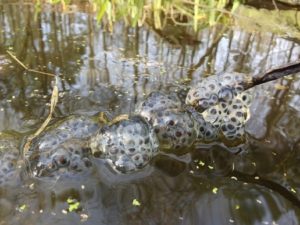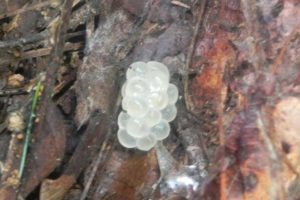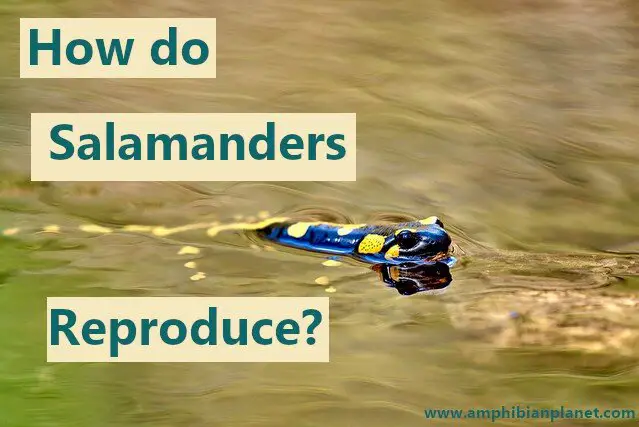In early spring, salamanders and other amphibians emerge from hibernation and head to the water to breed. But how do salamanders reproduce?
Salamanders reproduce via sexual reproduction. In the vast majority of salamander species, the male deposits a spermatophore on the ground or in the water, and the female picks this up with her cloaca to fertilize her eggs internally. She then lays eggs and attaches them to sticks and other vegetation or underneath rocks.
Some salamander species, such as the hellbender fertilize their eggs externally rather than internally.
In these salamanders, the female lays eggs, then the male positions himself alongside or slightly above them, spraying the eggs with sperm while swaying his tail and moving his hind limbs, which disperses the sperm uniformly.
Other salamanders such as the Alpine salamander do not lay eggs, but instead, give birth to live young.
The Majority of Lay Eggs
Arboreal salamanders (a type of salamander that climbs trees) are even known to lay their eggs high up in the forest canopy to protect them from predators on the ground.
Most Salamanders Lay Eggs in the Water

On the first rainy night of spring, when the temperatures are hovering around 40-50°F, thousands of salamanders emerge from hibernation and migrate to breeding ponds. This mass migration is often referred to as “the big night”.
Many herp enthusiasts will travel to see this event and watch thousands of salamanders and frogs on their way to the wetlands where they can breed.
Salamanders can breed in ponds, lake edges, slow-moving streams, roadside ditches, or even deep tire tracks, but most salamanders very strongly prefer to breed in something called “vernal pools“
Vernal pools are seasonal pools of water that are formed when depressions on the ground are filled with water from melting snow and falling rain.
They are typically small and shallow, and unlike a pond or lake, they have no permanent source of water. This means they dry up in the summer.
Since they are temporal, they do not have fish that could eat the eggs before they hatch. This makes them ideal breeding sites.

Once in the water, salamanders will mate and the females will fertilize their eggs.
In most species, the male salamander deposits a packet of sperm (spermatophore) on the pond bottom and tries to draw the female over the top. The female salamander then picks up the sperm packet with her cloaca and fertilizes her eggs’ internally.
She then lay eggs and attaches them to submerged vegetation or on the underside of submerged rocks near the water’s surface.
Some Salamanders Lay Eggs on Land
Some salamanders such as the red-backed salamander lay their eggs in dark damp environments on land, rather than in the water. This could be in moist soil burrows, in damp rotting logs, deep in decaying leaf litter, or on the underside of rocks.

Arboreal salamanders are even known to lay their eggs at the base of tree branches, high up in the forest canopy to protect them from predators on the ground.
Naturally, salamanders that lay their eggs on land will have a fully terrestrial breeding process. In many species, the male will produce a spermatophore (a sperm packet) and deposit it on the ground. He will then lead the female to the spermatophore so she can stand over it.
As she stands over it, she will pick it up into her cloaca to fertilize her eggs’ internally.
Unlike salamander eggs laid in the water, eggs laid on land do not have a layer of jelly surrounding the egg mass.
Instead, the individual eggs have soft egg sacks to protect them from the elements and are sometimes covered in slime.
The female salamanders usually guard their eggs until they hatch to protect them from predators
Some Salamanders Give Birth to Live Young
A few salamander species, most notably the fire and alpine salamander do not lay eggs as most salamanders do. Rather, they give birth to live young.

These salamanders mate on land and fertilize their eggs internally, just like the fully terrestrial egg-laying salamanders. The embryos then develop inside their eggs’ inside the mother salamander’s body and hatch just before birth. This is known as “ovoviviparity“.
To give birth, a female fire salamander will crawl backward and immerse her cloaca in shallow, usually slow-moving water. She then releases about 15 to 70 well-developed aquatic larvae, but this number can vary depending on the subspecies.
However, alpine salamanders and Salamandra s. bernardez (a subspecies of fire salamander) are unique because they give birth to fully-developed juveniles who live a fully terrestrial life from the moment of their birth.
In these salamanders, an embryo develops from the first egg in each uterus. The embryo then feeds on the yolk of the other eggs which provide enough nutrition to sustain the developing embryo until it is ready to be born.
Pregnancy can last 2-3 years and the female salamander will give birth in a damp protected environment to keep the newborns safe from predators.
Some Salamanders Have External Fertilization
Some salamanders such as the Asiatic salamanders and the hellbender fertilize their eggs externally, very similar to how most frogs fertilize their eggs.

In hellbenders, the male will excavate a nest under a rock or log, and guide the female into his nest to lay her eggs.
As the female begins to deposit her eggs, the male simultaneously releases sperm to fertilize the eggs. A single female can lay anywhere from 100 to as many as 300 eggs in a single breeding season.
Once the egg laying is complete, the male will remain in the nest to protect the eggs from predators until they hatch.
How Aquatic Salamanders Reproduce
Apart from hellbenders and the Asiatic giant salamanders, most other aquatic salamanders have internal egg fertilization.
Axolotls mate in the same way that most salamanders do. The male releases a spermatophore and the female picks it up to fertilize her eggs internally. When laid, the eggs are attached to submerged twigs or other vegetation.
Mudpuppies are slightly different in that they excavate nests, very similarly to hellbenders. After internal egg fertilization, the female will turn upside down and attach her eggs to the bottom of the rock (or log) over her nest.
Howver, unlike hellbenders, it is the female mudpuppy rather than the male who remains to defend the eggs from predators.
Some Salamanders Can Reproduce Asexually
Although most salamanders reproduce via sexual reproduction, a few salamander species such as the silvery salamander can reproduce asexually using a form of parthenogenesis called ‘kleptogenesis‘.
In these salamanders, the females steal sperm from closely related salamander species. However, the sperm isn’t to fertilize the eggs’, rather, it induces the eggs to develop independently.
The result is that the offspring are exact clones of their mothers without the contribution of genetic material from sperm. Also, the offspring are all female.
Related Questions:
Question: At What Age Are Salamanders Able to Reproduce?
Answer: Depending on the species (and environmental conditions) salamanders can take anywhere from as little as two years to as much as seven years before they are sexaully mature.
For example, red-backed salamanders reach sexual maturity in 2 years, red salamanders in 4 years, and hellbenders only reach sexual maturity after six to eight years.
Question: For How Long Do Salamanders Lay Eggs?
Answer: Depending on the species, egg laying may last from 1 day to as long as 3 months.
Question: Do Salamanders Eat Their Own Eggs?
Answer: Many salamander species are known to eat their own and other salamander eggs. Hellbenders sometimes eat more than half of their own eggs.
Final Thoughts
The vast majority of salamanders reproduce via sexual reproduction and lay internally fertilized eggs.
Most salamander will lay their eggs in the water, and attach them to submerged rocks, twigs, and other vegetation.
However, some salamanders such as the red-backed salamander lay their eggs in damp environments on land rather than in the water.
Salamanders such as the fire and the alpine salamander do not lay eggs, instead, they give birth to live young.
Silvery salamanders are unique in that they can reproduce asexually without the need for genetic material from sperm.


